Abstract
The floating platform motion of an offshore wind turbine system can exacerbate output power fluctuations and increase fatigue loads. This paper proposes a new scheme based on a fast second-order sliding mode (SOSM) control and an adaptive super-twisting extended state observer to suppress the platform motion and power fluctuation. Firstly, an affine nonlinear model of the floating wind turbine pitch system is constructed. Then, a fast SOSM pitch control law is adopted to adjust the blade pitch angle, and a new adaptive super-twisting extended state observer is constructed to achieve total disturbance observation. Finally, simulations are conducted under two cases of wind and wave conditions based on FAST (fatigue, aerodynamics, structures, and turbulence) and MATLAB/Simulink. Compared with the traditional proportional integral (PI) control scheme and standard super-twisting control scheme, the platform roll under the proposed scheme is reduced by 13% and 4%, and pitch is reduced by 16% and 3% in Case 1. Correspondingly, the roll is reduced by 9% and 15%, and pitch is reduced by 7% and 1% in Case 2. For the tower top pitch and yaw moment, load reductions of 7% and 3% or more are achievable compared with those under the PI control scheme. It is indicated that the proposed scheme is more effective in suppressing floating platform motion, stabilizing output power of the wind turbine system, and reducing tower loads.
1. Introduction
Wind energy utilization is an important measure to achieve the goal of carbon neutrality, and solve the energy crisis and environmental pollution [1]. The development and utilization of onshore wind energy has gradually moved towards industrialization and large-scale direction. However, onshore wind farms are severely limited by resource regions, and face visual and noise impacts [2]. Offshore wind power has become the key development direction for countries around the world due to its advantages of saving land, stable operation, and being close to load center of the grid [3,4]. According to the different types of platform foundation, offshore wind turbines are divided into fixed and deep-sea floating types [5]. With the gradual saturation of the development intensity of wind power resources in the intertidal zone and offshore areas, and the growing demand for environmental protection in coastal areas, it will be an inevitable trend for offshore wind power to move from the intertidal zone and offshore to the deep sea. In recent years, the floating type suitable for the deep sea has attracted wide attention [6].
The platform foundation of a floating offshore wind turbine (FOWT) is easily excited by wind and wave loads, leading to more platform motion, which makes the wind turbine withstand more fatigue loads [6,7]. Additionally, the coupling between blade pitch control system and platform dynamics aggravates the platform motion when wind speed is higher than the rated value [8,9]. Repeated platform motion does not only damage mechanical components and reduce the service life of the FOWT, but also cause fluctuations in power output and deteriorate power generation performance. Although the control methods for onshore wind turbines are becoming increasingly mature, they cannot be directly applied for the FOWT. There are relatively few controllable degrees of freedom. The goals of load suppression and power regulation are mutually restrictive. It is particularly important to design a new control scheme to reduce platform motion, suppress fatigue loads, and stabilize power generation.
The methods for inhibiting platform motion and reducing load are currently mainly divided into two categories. One is to use structural-vibration-control-tuned mass dampers (TMDs) on the FOWT to increase control freedom. TMDs are used for passive control to limit nacelle or platform motion. Lackner et al. [10] developed an advanced modeling tool to determine optimal parameters for the TMD system, thereby improving the structural response of offshore wind turbines. Based on this, Stewart et al. [11] adopted a genetic algorithm to find the global optimization design of TMDs, determining the TMD parameters and conducting sensitivity analysis in order to reduce fatigue damage to the tower. Sarkar et al. [12] conducted research on passive tuned mass-damper-inerter (TMDI); compared with classical TMDs, TMDIs exhibit stronger vibration control ability. However, the complexity of a TMD system is related to the number of degrees of freedom that need to be controlled along each axis. As more degrees of freedom are added, the TMD system becomes more complex and requires additional installation space and costs [13]. Another method is to adjust the blade pitch angle of the FOWT based on some advanced control algorithms such as PI control [14], predictive control [15], state-space feedback control [16] and linear quadratic regulator [17,18]. These control methods are based on linearized models. Yet, as the wind energy conversion system is a set of typical complex dynamic systems, and there are wind and wave disturbances. The effectiveness of these linear model controllers may diminish with changes in the operating point. Therefore, it is of great importance to improve the system’s robustness.
Sliding mode control (SMC) has strong robustness to disturbances and unmodeled dynamics, and can overcome system uncertainty. SMC studies for the onshore wind power system have been gradually carried out [19,20]. However, FOWT control is more complex, and multiple cooperative objectives need to be achieved through pitch control. Meanwhile, severe chattering in traditional first-order SMC can negatively impact the pitch actuator. Shah et al. [21] proposed a scheme combining terminal sliding mode with a translational oscillator for a barge-type FOWT. Yet, the chattering phenomenon induced by the first-order SMC is prone to damage the pitch actuator. High-order SMC, which has become a research focus of the sliding mode algorithm in recent years, achieves chattering suppression by hiding high-frequency switching in the high-order differential of the control variable [22]. The super-twisting second-order SMC algorithm is a special form of high-order SMC algorithms. It does not require known differential information of sliding mode variables and can achieve continuous control [23]. Recently, Zhang et al. [24,25,26] attempted to apply second-order SMC to the FOWT control, and it has played a positive role in regulating output power and stabilizing the floating platform. However, their design scheme is based on the linear model of a certain equilibrium point which describes the system as a black box, and SMC is directly executed. This approach ignores wind/wave description and the known parts of the system. This leads to an excessive SMC effect, which worsens the damage to the pitch actuator. Our team has also carried out a preliminary study on pitch control via second-order SMC [27].
In fact, the FOWT is affected by external disturbances such as wind, wave, and current, as well as internal parameter perturbations. However, SMC has the disadvantage of being insensitive to unmatched uncertainties. Moreover, the control gains of the sliding mode controller are usually chosen conservatively to obtain good performance in the presence of disturbances. To further alleviate the well-known chattering problem and maintain nominal control of SMC in the presence of both matched and nonmatched disturbances, some schemes combining the disturbance observer with SMC have been presented [28,29,30,31,32]. However, the FOWT faces both matched and unmatched disturbances. Whether based on a model or not, existing observers cannot simultaneously estimate these disturbances. Moreover, the observer gain can only be monotonically increased, which is not truly adaptive.
Hence, this paper proposes a new composite pitch control scheme for load suppression and power regulation of the FOWT. The proposed scheme is verified via FAST and MATLAB/Simulink. Furthermore, power spectral density (PSD) analysis of the FOWT output power and floating platform motion is conducted. The novelty mainly includes the following: (1) A new scheme based on a fast SOSM control and an adaptive super-twisting extended state observer is proposed to suppress the platform motion and power fluctuation of FOWT. The controller combines the advantages of the linear algorithm and the super-twisting control (STC) algorithm to handle disturbances near and far from the origin. (2) For the nonlinear affine uncertain system with pitch angle and speed, an extended state observer is designed based on an adaptive super-twisting algorithm to observe the total disturbances. The proposed control scheme can be more effective in restraining floating platform motion, stabilizing generator output power and restraining tower load, and has stronger adaptability to the environment than PI and the standard super-twisting control scheme.
This paper is organized as follows. Section 2 introduces a 5 MW offshore wind turbine model which utilizes a barge-type floating platform. Section 3 provides a detailed analysis of the proposed control scheme. Section 4 describes the simulation environment and simulation settings, and discuss the effectiveness of the proposed scheme on a 5 MW barge-type FOWT. Finally, Section 5 summarizes the conclusions of our work.
Table 1 shows the acronyms used within this paper for a better understanding.

Table 1.
Acronyms used.
2. FOWT Model
This study’s object is the NREL (National Renewable Energy Laboratory) 5 MW wind turbine, shown in Figure 1, with the ITI Energy barge-type floating platform [33]. The platform is stabilized by a mooring system which employs the catenary type with 8 anchor chains rectangular mooring method.
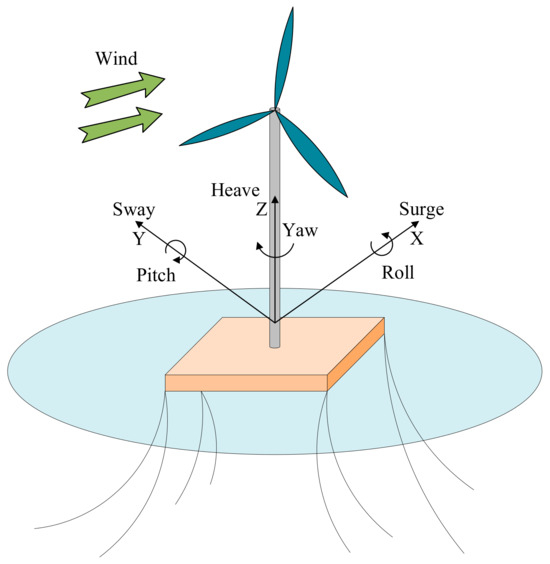
Figure 1.
Barge-type FOWT model.
The mechanical dynamics relationship of the wind turbine is as follows [34,35]:
in which is the viscous friction coefficient, is generator torque, is the inertia coefficient, is the gearbox ratio, is the rotor angular velocity of the wind turbine, and is rotor torque. Their relationship is
where is mechanical power captured by wind turbine, is air density, is rotor radius, is tip speed ratio, is incoming wind speed, is pitch angle, and is power capture coefficient of wind turbine, which can be simplified as
where , , is the error after simplification, and the coefficient is the nominal value of .
There are errors between the actual and nominal values of and . These bounded unknown values can be expressed as
where and are nominal values, and are uncertainties, and and are the unknown upper bound.
In summary, the wind turbine model can be described as
where is caused by system parameter uncertainty and wave disturbance. Considering the physical limitations of the wind turbine, is bounded and unknown.
3. Control Scheme
To stabilize output power, reduce platform motion, lower fatigue load, and realize robust control of the FOWT, this paper proposes a new collective pitch control scheme combining the sliding mode controller and observer with algorithm simplicity consideration. A fast super-twisting SOSM pitch controller is designed to adjust the pitch angle, and an adaptive super-twisting extended state observer is constructed to observe and compensate for the total system disturbances.
The sliding mode function is designed as
where is a positive parameter, and is the rated rotor angular velocity with platform displacement consideration [36], which is represented as
where is the rated rotor angular velocity without platform displacement consideration, is the platform pitch angular velocity, and is the user-defined positive parameter. When the wind turbine tilts upwind, more energy can be obtained from wind by increasing the rated rotor angular velocity ; thereby, the platform motion is suppressed. When the wind turbine pitches in the direction of wind, less energy is extracted due to reducing , and suppressing its movement again. Thus, the effect of suppressing platform motion is achieved by tracking the rated rotor angular velocity through the actual rotor angular velocity.
By substituting Equation (5) into Equation (6), it can be deduced that
where is the nominal value, is the total system disturbances, and is the unknown upper bound of the total disturbance derivative.
The control input is designed as
where is the auxiliary control. Then, Equation (8) is converted as
For Equation (10), standard super-twisting second-order SMC can be applied.
where and are control gains. SOSM with respect to can be established by selecting parameters and [37].
The total disturbances value is unknown but its derivative has an upper bound . If a disturbance observer is used to observe the disturbances in real time, the controller gains can be effectively lowered and the disturbances’ impact on the FOWT can be reduced. To define this, is the observed value of and is the observation error, . Then, Equation (8) becomes
The control input is redesigned as
Then, Equation (12) is converted as
For Equation (14), the control law Equation (11) can be used. The standard second-order SMC has a good performance to deal with strong disturbances near the origin. Yet, its ability to handle disturbances far from the origin is not ideal. Linear algorithms can easily handle strong disturbances far from the origin. Thus, Equation (11) is improved by combining the advantages of the linear algorithm and the STC algorithm. The improved fast SOSM controller is presented as
The proof for stability and finite-time convergence can be found in [38], in which the pure mathematics model is studied.
In Equation (13), is unknown. Next, we will provide a detailed description about how to obtain the observed value.
The total disturbances value in Equation (8) is expanded into a new state variable ; then,
where is the derivative of . Define the observed value of as and the observed value of as . The sliding mode observer is designed as
where and are the observer gains. Define the observer error dynamics ,, then the observer error can be expressed as
where .
The values of gains and are dependent on N, which is hard to obtain in the FOWT system. To cope with this difficulty, barrier function-based SMC [39,40] is deeply analyzed and an adaptive super-twisting SOSM observer is proposed. Define and , then Equation (17) becomes
is the adaptive gain, which is defined as
where and are arbitrary constants, is a positive parameter, and is a provided fixed value ().
is the time required for to reach . For all , is true. This remark will be proved in two steps. The first step is to prove that there is a finite time such that in Equation (19) satisfies .
To assume and according to Equation (20), the variable gain is as long as . At the same time, the right side of Equation (19) is sublinear relative to . This dynamic interval is defined by and its form is . To complete the proof by contradiction, it is sufficient to prove that is the required time .
It is assumed that on and is positive. From the second equation in Equation (19), it can be obtained as
It can be easily found that . becomes and remains negative in finite time. From the first equation of Equation (19),
Thus, the sliding surface converges to zero in finite time, which is contrary to the previous assumption that on .
The second step is to prove that for all , holds, considering variable transformation , where and . Then, it can be written as
since
such that is satisfied, and the term can be written as
where . Substituting Equations (25) and (19) into Equation (23), then:
Define and , and use ′ to denote the derivative with respect to . Then, Equation (26) can be rewritten as
The second equation of Equation (27) shows that is bounded. So, has a linear growth on at most. It can be found that the time derivative of the positive function is upper-bounded by a function with linear growth on from the first equation of Equation (27). Thus, it can be easily found that . QED□
In summary, the new composite super-twisting sliding mode (CSTSM) scheme proposed in this paper is shown in Figure 2. An integral sliding mode surface was designed based on the error between the reference rotor speed and the actual rotor speed. The fast SOSM control law is constructed based on the sliding mode surface. The adaptive observer for which adaptive gain is produced with the help of barrier function is designed. The designed control law (15) and observer (17), combined with the feedback control, produce the required pitch angle.
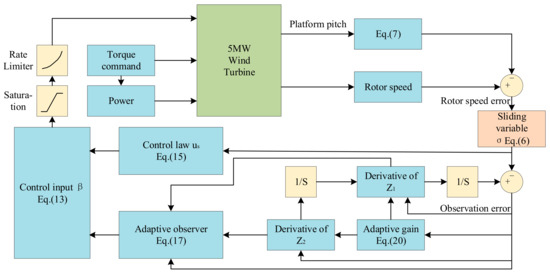
Figure 2.
The CSTSM control scheme.
To compare control performance, the standard super-twisting sliding mode (SSTSM) control and PI control schemes are also designed. The SSTSM control law is
where and are the control gains.
The PI control scheme is designed as:
where and are the proportional and integral coefficients, respectively.
4. Simulation Results and Discussion
The simulation experiment was conducted on the 5 MW ITIBige4 FOWT, and the proposed controller and observer are developed in the MATLAB/Simulink environment. The simulation runtime was set to 600 s. All 24 degrees of freedom were enabled in FAST, and wind data were generated using the software Turbsim v2.00. The wind turbine parameters are shown in Table 2 [41]; Figure 3 is the simulink diagram of the proposed scheme.

Table 2.
Main parameters of the FOWT.
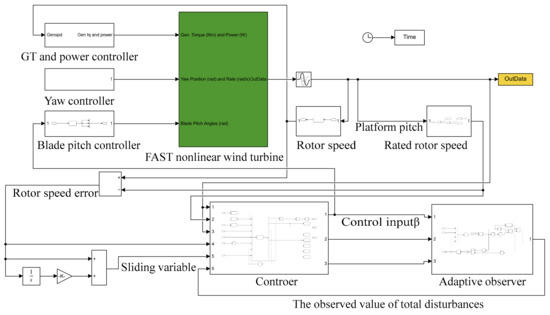
Figure 3.
Simulink diagram of CSTSM.
Due to the physical limitations of the FOWT, the constraints of the pitch angle and its rate of change are [0°, 90°], and [−8, 8] (°)/s. Two wind and wave conditions are shown in Table 3, and their respective variation is shown in Figure 4. This paper compared the performances of PI control, SSTSM control, and the CSTSM control. The fatigue loads on blades and tower were analyzed by the damage equivalent load (DEL) of MLife [42]. The DEL is obtained with a life of 20 years and a frequency of 1 Hz.

Table 3.
Environmental conditions.
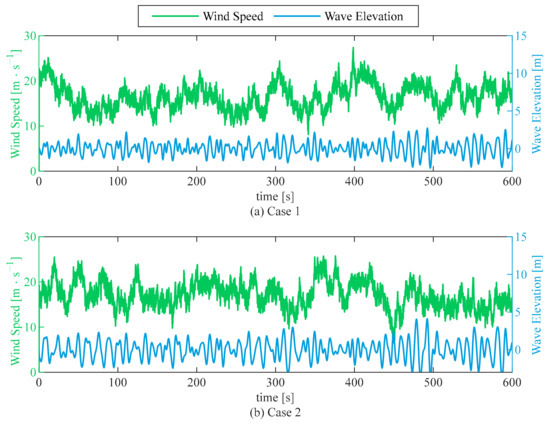
Figure 4.
Environmental conditions for Case 1 and Case 2.
The control parameters of the CSTSM were selected as , , , , , , and . The comparative control scheme SSTSM parameters were designed as , and , and the PI control parameters were designed as , and .
4.1. Time Domain Analysis of Power and Platform Motion
The root mean square (RMS) of power error and platform motion angular velocity are used to compare the control performance of the three schemes in two environments. As shown in Figure 5, compared with the PI scheme, the SSTSM scheme and the CSTSM scheme play a better role in stabilizing power. In Case 1, the platform roll under the CSTSM scheme is reduced by 13% and 4%, and pitch is reduced by 16% and 3%, respectively, compared with that under PI control scheme and SSTSM scheme. In Case 2, the roll is reduced by 9% and 15%, and the pitch is reduced by 7% and 1%, respectively. In summary, the effect under the CSTSM scheme is better than that under the PI control scheme and SSTSM scheme, and the CSTSM scheme has better adaptability to the external environment. Figure 6 shows the responses of rotor speed, power and platform motion angular velocity after the three schemes are applied, respectively, in two cases.
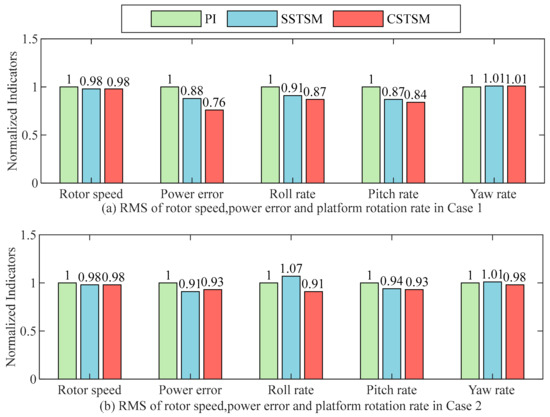
Figure 5.
Normalized RMS values under the three schemes in Case 1 and Case 2.
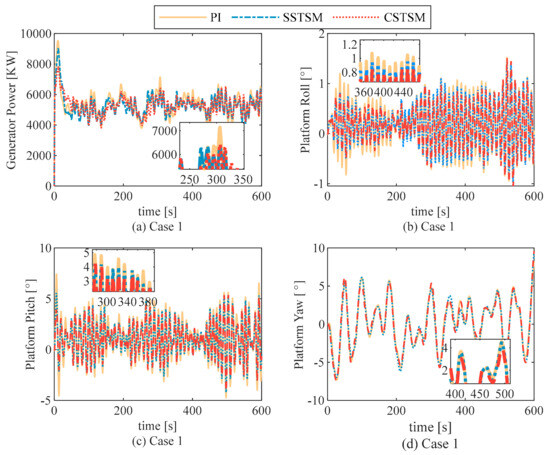
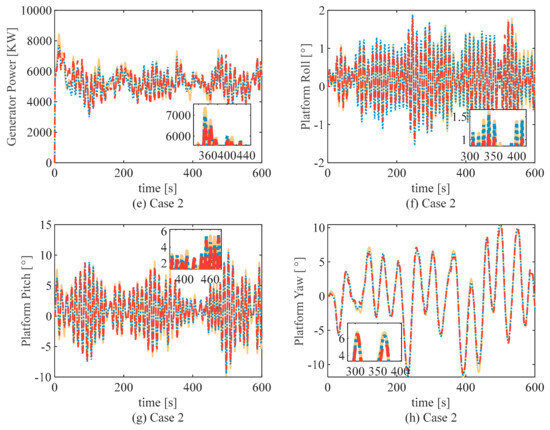
Figure 6.
Power and platform motion response under Case 1 and Case 2.
4.2. Formatting of Mathematical Components
In this section, power spectral density (PSD) analysis is conducted on the output power and platform motion of the FOWT. The frequency response curves of wind speed and wave height under the two cases are presented in Figure 7. As shown in Figure 7, following the initial state, the wind speed exhibits maximum energy around 0.015 Hz in Case 1; the primary frequency range for wave height lies between 0.095 and 0.42 Hz. For Case 2, the maximum energy occurs at approximately 0.01 Hz, and the primary frequency range for wave height spans from 0.075 to 0.36 Hz. Figure 8 illustrates the output power in the low-frequency range, alongside the response curves of platform roll and pitch under the influence of three control schemes across two cases. As discernible from Figure 8a,d, regarding FOWT output power, the CSTSM control scheme exhibits superior control efficacy compared to the PI control scheme at peak wind speed energy. As can be observed from Figure 8b,c,e,f, the CSTSM control scheme can still maintain a good inhibition effect on platform roll and pitch despite changes in the environment.
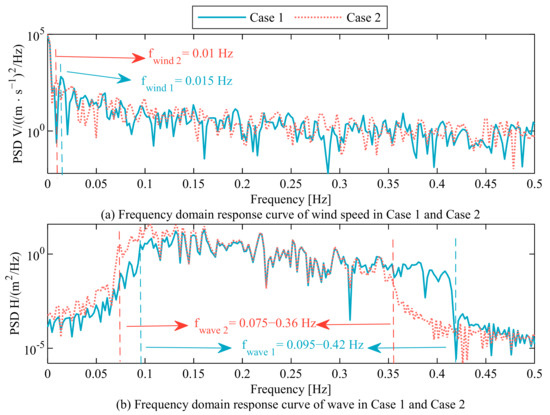
Figure 7.
Frequency domain response of wind speed and wave in Case 1 and Case 2.
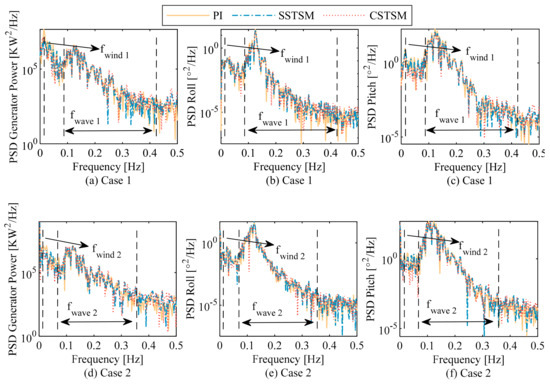
Figure 8.
Frequency domain response of power and platform in Case 1 and Case 2.
4.3. Tower and Blade Load Analysis
In Figure 9, the DEL normalization values of the tower and blade roots under the three schemes are compared. In Case 1, for the tower top pitch moment, load reductions of 9% and 3% are achievable compared with that under the PI control scheme and SSTSM scheme. For the tower top yaw moment, load reductions of 7% and 1% are achievable. Both the SSTSM scheme and the CSTSM scheme reduce the overall DEL normalized values of the tower base moment and the tower top moment, and the CSTSM scheme has a better effect on load suppression than the SSTSM scheme. When the external environment is changed, as shown in Case 2, for the tower top pitch moment, load reductions of 7% and 2% are achievable compared with that under the PI control scheme and SSTSM scheme. For the tower top yaw moment, load reductions of 3% and 6% are achievable. The CSTSM scheme can still effectively reduce the overall DEL normalized values of tower base moment and tower top moment compared with SSTSM scheme. It can be seen that the CSTSM scheme has stronger adaptability to the environment in terms of tower load suppression. Figure 10a,b show the time domain response curves of the blade pitch angle for the three control schemes applied to the floating wind turbine under Case 1 and Case 2. It can be observed from the diagrams when compared with the PI control scheme that the blade pitch angle of both the SSTSM scheme and the CSTSM scheme exhibits bigger fluctuation. Figure 10c,d display the pitch angle frequency domain response curves of the three control schemes for the floating wind turbine under Case 1 and Case 2. It is evident from the diagrams that in comparison with the PI control scheme, the blade pitch fluctuation energy of both the SSTSM scheme and CSTSM scheme is larger. But, blade pitch saturation and change rate limit are considered in the simulation, and the DEL value of the inside and outside plane moment at the blade root does not increase much, that is, the influence of blade actuator fluctuation on blade fatigue life is within a reasonable range.
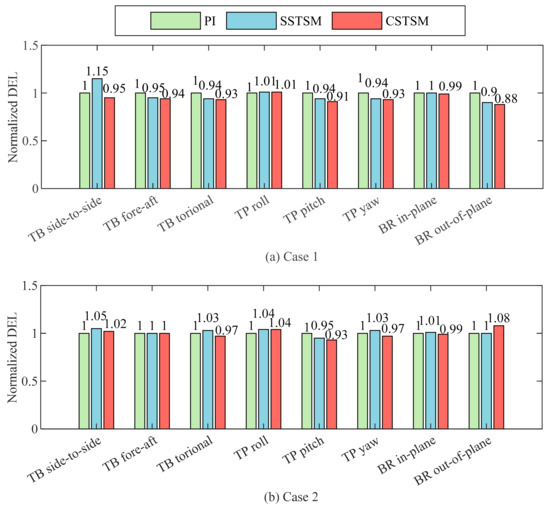
Figure 9.
Normalized DEL values of tower base moments, tower top moments and blade root moments obtained with the three schemes in Case 1 and Case 2.
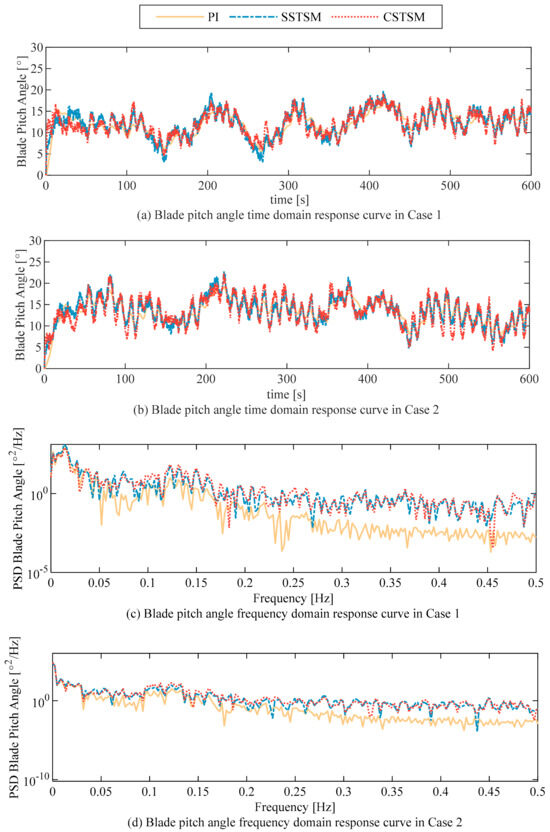
Figure 10.
Blade pitch angle obtained with the three schemes in Case 1 and Case 2.
4.4. Observer Performance
Simulation results prove that the CSTSM scheme can effectively reduce the fatigue load of the tower. In addition, this scheme can observe and compensate for disturbances and uncertainties. As shown in Figure 11a,c, the observer gains can be dynamically adjusted with disturbances, which greatly reduces parameter adjustment workload and control gains. The observed sliding mode surface error is shown in Figure 11b,d. The observer can still maintain good performance after the external environment is changed.
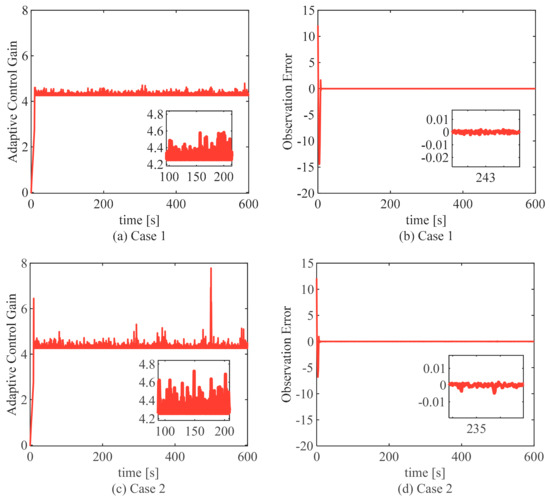
Figure 11.
Adaptive control gains and observation error in Case 1 and Case 2.
5. Conclusions
In this paper, a new composite blade pitch control scheme based on a fast SOSM controller and an adaptive super-twisting sliding mode extended state observer is proposed. A new adaptive super-twisting extended state observer is constructed to achieve total disturbance observation and compensated to reduce the controller gains. Compared with the PI control scheme and SSTSM scheme, in Case 1, the platform roll under the proposed CSTSM scheme is reduced by 13% and 4%, and pitch is reduced by 16% and 3%. Respectively, in Case 2, the roll is reduced by 9% and 15%, and pitch is reduced by 7% and 1%. For the tower top pitch moment, load reductions of 7% and 2% or more are achievable compared with those under the PI control scheme and SSTSM scheme. For the tower top yaw moment, load reductions of 3% and 1% or more are achievable compared with the PI control scheme and SSTSM scheme. Therefore, the proposed CSTSM scheme is more effective in restraining floating platform motion, stabilizing output power and restraining tower load, and has stronger adaptability to the environment. It should be noted that the proposed CSTSM scheme is carried out under simulation conditions, yet, the FOWT faces a more complex operating environment and unknown factors in actual operation. In future work, further optimization of the algorithm and its application in practice will be a breakthrough in this field.
Author Contributions
Conceptualization, W.Y. and Y.H.; data curation, W.Y. and R.M.; formal analysis, Y.H. and G.Y.; methodology, W.Y. and Y.H.; project administration, Y.H.; resources, W.Y.; supervision, R.M. and M.H.; validation, R.M.; writing—original draft, W.Y. and R.M.; writing—review and editing, W.Y., G.Y. and Y.H. All authors have read and agreed to the published version of the manuscript.
Funding
This research was funded by Shandong Provincial Natural Science Foundation under Grant ZR2023MF034; National Natural Science Foundation of China under Grant 61803230; and Project of Shandong Province College Youth Innovation Technology Support Program under Grant 2019KJN023.
Institutional Review Board Statement
Not applicable.
Informed Consent Statement
Not applicable.
Data Availability Statement
Data are contained within the article.
Conflicts of Interest
The authors declare no conflict of interest.
References
- Jung, C.; Schindler, D. Efficiency and effectiveness of global onshore wind energy utilization. Energy Convers. Manag. 2023, 280, 116788. [Google Scholar] [CrossRef]
- Tian, H.; Soltani, M.N.; Nielsen, M.E. Review of floating wind turbine damping technology. Ocean Eng. 2023, 278, 114365. [Google Scholar] [CrossRef]
- Micallef, D.; Rezaeiha, A. Floating offshore wind turbine aerodynamics: Trends and future challenges. Renew. Sustain. Energy Rev. 2021, 152, 111696. [Google Scholar] [CrossRef]
- Shah, S.A.A.; Gao, B.; Ahmad, I.; Ullah, H.; Ahmed, N.; Saeed, A. Adaptive Backstepping Integral Sliding Mode Control for 5DOF Barge-Type OFWT under Output Constraint. J. Mar. Sci. Eng. 2023, 11, 492. [Google Scholar] [CrossRef]
- Shah, K.A.; Meng, F.; Li, Y.; Nagamune, R.; Zhou, Y.; Ren, Z.; Jiang, Z. A synthesis of feasible control methods for floating offshore wind turbine system dynamics. Renew. Sustain. Energy Rev. 2021, 151, 111525. [Google Scholar] [CrossRef]
- Ha, K.; Truong, H.V.A.; Dang, T.D.; Ahn, K.K. Recent control technologies for floating offshore wind energy system: A review. Int. J. Precis. Eng. Manuf.-Green Technol. 2021, 8, 281–301. [Google Scholar] [CrossRef]
- Zhang, M.; Li, X.; Tong, J.; Xu, J. Load control of floating wind turbine on a Tension-Leg-Platform subject to extreme wind condition. Renew. Energy 2020, 151, 993–1007. [Google Scholar] [CrossRef]
- Park, G.; Oh, K.-Y.; Nam, W. Bilinear tuned mass damper for spar-type floating wind turbines. Ocean. Eng. 2022, 261, 112081. [Google Scholar] [CrossRef]
- Clement, C.; Kosleck, S.; Lie, T. Investigation of viscous damping effect on the coupled dynamic response of a hybrid floating platform concept for offshore wind turbines. Ocean. Eng. 2021, 225, 108836. [Google Scholar] [CrossRef]
- Lackner, M.A.; Rotea, M.A. Passive structural control of offshore wind turbines. Wind. Energy 2011, 14, 373–388. [Google Scholar] [CrossRef]
- Stewart, G.; Lackner, M. Offshore wind turbine load reduction employing optimal passive tuned mass damping systems. IEEE Trans. Control. Syst. Technol. 2013, 21, 1090–1104. [Google Scholar] [CrossRef]
- Sarkar, S.; Fitzgerald, B. Vibration control of spar-type floating offshore wind turbine towers using a tuned mass-damper-inerter. Struct. Control Health Monit. 2020, 27, e2471. [Google Scholar] [CrossRef]
- Javier, L.; Eider, R.; Josu, J.; Santiago, A. Review of Control Technologies for Floating Offshore Wind turbines. Renew. Sustain. Energy Rev. 2022, 167, 112787. [Google Scholar]
- Larsen, T.J.; Hanson, T.D. A method to avoid negative damped low frequent tower vibrations for a floating, pitch controlled wind turbine. In Proceedings of the Journal of Physics: Conference Series; IOP Publishing: Bristol, UK, 2007; p. 12073. [Google Scholar]
- Zhang, Y.; Yang, X.; Liu, S. Data-driven predictive control for floating offshore wind turbines based on deep learning and multi-objective optimization. Ocean. Eng. 2022, 266, 112820. [Google Scholar] [CrossRef]
- Wakui, T.; Yoshimura, M.; Yokoyama, R. Multiple-feedback control of power output and platform pitching motion for a floating offshore wind turbine-generator system. Energy 2017, 141, 563–578. [Google Scholar] [CrossRef]
- Radaideh, A.; Bodoor, M.M.; Al-Quraan, A. Active and reactive power control for wind turbines based DFIG using LQR controller with optimal gain-scheduling. J. Electr. Comput. Eng. 2021, 2021, 1–19. [Google Scholar] [CrossRef]
- Sarkar, S.; Chen, L.; Fitzgerald, B.; Basu, B. Multi-resolution wavelet pitch controller for spar-type floating offshore wind turbines including wave-current interactions. J. Sound Vib. 2020, 470, 115170. [Google Scholar] [CrossRef]
- Yang, B.; Yu, T.; Shu, H.; Dong, J.; Jiang, L. Robust sliding-mode control of wind energy conversion systems for optimal power extraction via nonlinear perturbation observers. Appl. Energy 2018, 210, 711–723. [Google Scholar] [CrossRef]
- Kelkoul, B.; Boumediene, A. Stability analysis and study between classical sliding mode control (SMC) and super twisting algorithm (STA) for doubly fed induction generator (DFIG) under wind turbine. Energy 2021, 214, 118871. [Google Scholar] [CrossRef]
- Shah, S.A.A.; Gao, B.; Ahmed, N.; Liu, C. Advanced robust control techniques for the stabilization of translational oscillator with rotational actuator based barge-type OFWT. Proc. Inst. Mech. Eng. Part M J. Eng. Marit. Environ. 2021, 235, 327–343. [Google Scholar] [CrossRef]
- Han, Y.; Liu, X. Continuous higher-order sliding mode control with time-varying gain for a class of uncertain nonlinear systems. ISA Trans. 2016, 62, 193–201. [Google Scholar] [CrossRef]
- Liu, X.; Wang, C.; Han, Y. Second-order sliding mode control of DFIG based variable speed wind turbine for maximum power point tracking. Acta Autom. Sin. 2017, 43, 1434–1442. [Google Scholar]
- Zhang, C.; Gutierrez, S.; Plestan, F.; de León-Morales, J. Adaptive super-twisting control of floating wind turbines with collective blade pitch control. IFAC-Pap. 2019, 52, 117–122. [Google Scholar] [CrossRef]
- Zhang, C.; Plestan, F. Individual/collective blade pitch control of floating wind turbine based on adaptive second order sliding mode. Ocean. Eng. 2021, 228, 108897. [Google Scholar] [CrossRef]
- Gutierrez, S.V.; Zhang, C.; de Leon-Morales, J.; Plestan, F. A simplified version of adaptive super twisting—Application to the control of floating wind turbine. Control Eng. Pract. 2022, 125, 105208. [Google Scholar] [CrossRef]
- Li, S.; Han, Y.; Pan, W.; Liu, S.; Hou, M. Variable-gain higher-order sliding mode pitch control of floating offshore wind turbine. J. Mar. Sci. Eng 2021, 9, 1172. [Google Scholar] [CrossRef]
- Ali, S.A.; Langlois, N. Sliding mode control for diesel engine air path subject to matched and unmatched disturbances using extended state observer. Math. Probl. Eng. 2013, 2013, 712723. [Google Scholar] [CrossRef]
- Guermouche, M.; Ali, S.A.; Langlois, N. Super-twisting algorithm for DC motor position control via disturbance observer. IFAC-Pap. 2015, 48, 43–48. [Google Scholar] [CrossRef]
- Mohamed, G.; Sofiane, A.A.; Nicolas, L. Adaptive super twisting extended state observer based sliding mode control for diesel engine air path subject to matched and unmatched disturbance. Math. Comput. Simul. 2018, 151, 111–130. [Google Scholar] [CrossRef]
- Zhao, L.; Zheng, C.; Wang, Y.; Liu, B. A finite-time control for a pneumatic cylinder servo system based on a super-twisting extended state observer. IEEE Trans. Syst. Man Cybern. Syst. 2019, 51, 1164–1173. [Google Scholar] [CrossRef]
- Yang, Y.; Yan, Y.; Xu, X.; Gong, B. Super-twisting algorithm with fast super-twisting disturbance observer for steer-by-wire vehicles. Proc. Inst. Mech. Eng. Part D J. Automob. Eng. 2021, 235, 2324–2340. [Google Scholar] [CrossRef]
- Liu, Q.-S.; Miao, W.-P.; Yue, M.-N.; Li, C.; Wang, B.; Ding, Q. Dynamic response of offshore wind turbine on 3× 3 barge array floating platform under extreme sea conditions. China Ocean. Eng. 2021, 35, 186–200. [Google Scholar] [CrossRef]
- Jonkman, J.M.; Buhl, M.L. FAST User’s Guide; National Renewable Energy Laboratory: Golden, CO, USA, 2005; Volume 365. [Google Scholar]
- Colombo, L.; Corradini, M.L.; Ippoliti, G.; Orlando, G. Pitch angle control of a wind turbine operating above the rated wind speed: A sliding mode control approach. ISA Trans. 2020, 96, 95–102. [Google Scholar] [CrossRef] [PubMed]
- Lackner, M.A. An investigation of variable power collective pitch control for load mitigation of floating offshore wind turbines. Wind. Energy 2013, 16, 435–444. [Google Scholar] [CrossRef]
- Seeber, R.; Horn, M. Stability proof for a well-established super-twisting parameter setting. Automatica 2017, 84, 241–243. [Google Scholar] [CrossRef]
- Moreno, J.A.; Osorio, M. A Lyapunov approach to second-order sliding mode controllers and observers. In Proceedings of the 2008 47th IEEE Conference on Decision and Control, Cancun, Mexico, 9–11 December 2008; pp. 2856–2861. [Google Scholar]
- Obeid, H.; Fridman, L.; Laghrouche, S.; Harmouche, M.; Golkani, M.A. Adaptation of Levant’s differentiator based on barrier function. Int. J. Control 2018, 91, 2019–2027. [Google Scholar] [CrossRef]
- Obeid, H.; Laghrouche, S.; Fridman, L.; Chitour, Y.; Harmouche, M. Barrier function-based adaptive super-twisting controller. IEEE Trans. Autom. Control 2020, 65, 4928–4933. [Google Scholar] [CrossRef]
- Jonkman, J.; Butterfield, S.; Musial, W.; Scott, G. Definition of a 5-MW Reference Wind Turbine for Offshore System Development; National Renewable Energy Laboratory: Golden, CO, USA, 2009. [Google Scholar]
- Hayman, G. MLife Theory Manual for Version 1.00; National Renewable Energy Laboratory: Golden, CO, USA, 2012; Volume 74, p. 106. [Google Scholar]
Disclaimer/Publisher’s Note: The statements, opinions and data contained in all publications are solely those of the individual author(s) and contributor(s) and not of MDPI and/or the editor(s). MDPI and/or the editor(s) disclaim responsibility for any injury to people or property resulting from any ideas, methods, instructions or products referred to in the content. |
© 2023 by the authors. Licensee MDPI, Basel, Switzerland. This article is an open access article distributed under the terms and conditions of the Creative Commons Attribution (CC BY) license (https://creativecommons.org/licenses/by/4.0/).